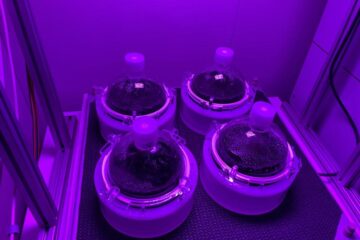UT Southwestern researchers probe mechanisms of infection

Researchers at UT Southwestern Medical Center are the first to identify the receptor, known as QseE, which resides in a diarrhea-causing strain of E coli.
The receptor senses stress cues from the bacterium's host and helps the pathogen make the host ill. A receptor is a molecule on the surface of a cell that docks with other molecules, often signaling the cell to carry out a specific function.
The study is available online and in a future issue of the Proceedings of the National Academy of Sciences. Dr. Vanessa Sperandio, associate professor of microbiology at UT Southwestern and the study's senior author, said QseE is an important player in disease development because the stress cues it senses from a host, chiefly epinephrine and phosphate, are generally associated with blood poisoning, or sepsis.
“Patients with high levels of phosphate in the intestine have a much higher probability of developing sepsis due to systemic infection by intestinal bacteria,” Dr. Sperandio said. “If we can find out how bacteria sense these cues, then we can try to interfere in the process and prevent infection.”
Millions of potentially harmful bacteria exist in the human body, awaiting a signal from their host that it's time to release their toxins. Without those signals, the bacteria pass through the digestive tract without infecting cells. What hasn't been identified is how to prevent the release of those toxins.
“There's obviously a lot of chemical signaling between host and bacteria going on, and we have very little information about which bacteria receptors recognize the host and vice versa,” Dr. Sperandio said. “We're scratching at the tip of the iceberg on our knowledge of this.”
In 2006, Dr. Sperandio's lab was the first to identify the receptor QseC sensor kinase, a molecule found in the membrane of a diarrhea-causing strain of E coli known as enterohemorrhagic Escherichia coli, or EHEC. Prior research by Dr. Sperandio found that when a person ingests EHEC – which is usually transmitted through contaminated food such as raw meat – it travels peacefully through the digestive tract until reaching the intestine. There, chemicals produced by the friendly gastrointestinal microbial flora and the human hormones epinephrine and norepinephrine alert the bacteria to its location.
Once QseC recognizes the stress hormones, it initiates a cascade of genetic activations in which EHEC colonizes the intestine and moves toxins into human cells, altering the makeup of the cells and robbing the body of nutrients.
“The bacteria get what they want – nourishment – and the person ends up getting diarrhea,” Dr. Sperandio said.
The new study identifies QseE, a receptor only found in intestinal bacteria, as the receptor that ends this QseC-initiated cascade. It also provides the timing for the bacterium's actions, including the regulation of the genes necessary for EHEC to cause diarrhea.
“EHEC needs both receptors to be fully virulent and express its toxins,” Dr. Sperandio said. “When people are stressed they have more epinephrine and norepinephrine being released. Both of these human hormones activate the receptors QseC and QseE, which in turn trigger virulence. Hence, if you are stressed, you activate bacterial virulence.”
Dr. Sperandio said the findings also suggest that there may be more going on at the genetic level in stress-induced illness than previously thought.
“The problem may not only be that the stress signals are weakening your immune system, but that you're also priming some pathogens at the same time,” she said. “Then it's a double-edged sword. You have a weakened immune system and pathogens exploiting it.”
Previous research by Dr. Sperandio found that phentolamine, an alpha blocker drug used to treat hypertension, and a new drug called LED209 prevent QseC from expressing its virulence genes in cells.
The next step is to test whether phentolamine has the same effect on QseE.
Media Contact
More Information:
http://www.utsouthwestern.eduAll latest news from the category: Life Sciences and Chemistry
Articles and reports from the Life Sciences and chemistry area deal with applied and basic research into modern biology, chemistry and human medicine.
Valuable information can be found on a range of life sciences fields including bacteriology, biochemistry, bionics, bioinformatics, biophysics, biotechnology, genetics, geobotany, human biology, marine biology, microbiology, molecular biology, cellular biology, zoology, bioinorganic chemistry, microchemistry and environmental chemistry.
Newest articles

How blue-green algae manipulate microorganisms
Research team at the University of Freiburg discovers previously unknown gene that indirectly promotes photosynthesis. Cyanobacteria – also called blue-green algae – are known as the “plants of the ocean”…

Combatting disruptive ‘noise’ in quantum communication
In a significant milestone for quantum communication technology, an experiment has demonstrated how networks can be leveraged to combat disruptive ‘noise’ in quantum communications. The international effort led by researchers…

Stretchable quantum dot display
Intrinsically stretchable quantum dot-based light-emitting diodes achieved record-breaking performance. A team of South Korean scientists led by Professor KIM Dae-Hyeong of the Center for Nanoparticle Research within the Institute for…





















